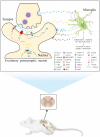Chronic Pain after Bone Fracture: Current Insights into Molecular Mechanisms and Therapeutic Strategies
- PMID: 36009119
- PMCID: PMC9406150
- DOI: 10.3390/brainsci12081056
Chronic Pain after Bone Fracture: Current Insights into Molecular Mechanisms and Therapeutic Strategies
Abstract
Bone fracture following traumatic injury or due to osteoporosis is characterized by severe pain and motor impairment and is a major cause of global mortality and disability. Fracture pain often originates from mechanical distortion of somatosensory nerve terminals innervating bones and muscles and is maintained by central sensitization. Chronic fracture pain (CFP) after orthopedic repairs is considered one of the most critical contributors to interference with the physical rehabilitation and musculoskeletal functional recovery. Analgesics available for CFP in clinics not only have poor curative potency but also have considerable side effects; therefore, it is important to further explore the pathogenesis of CFP and identify safe and effective therapies. The typical physiopathological characteristics of CFP are a neuroinflammatory response and excitatory synaptic plasticity, but the specific molecular mechanisms involved remain poorly elucidated. Recent progress has deepened our understanding of the emerging properties of chemokine production, proinflammatory mediator secretion, caspase activation, neurotransmitter release, and neuron-glia interaction in initiating and sustaining synaptogenesis, synaptic strength, and signal transduction in central pain sensitization, indicating the possibility of targeting neuroinflammation to prevent and treat CFP. This review summarizes current literature on the excitatory synaptic plasticity, microgliosis, and microglial activation-associated signaling molecules and discusses the unconventional modulation of caspases and stimulator of interferon genes (STING) in the pathophysiology of CFP. We also review the mechanisms of action of analgesics in the clinic and their side effects as well as promising therapeutic candidates (e.g., specialized pro-resolving mediators, a caspase-6 inhibitor, and a STING agonist) for pain relief by the attenuation of neuroinflammation with the aim of better managing patients undergoing CFP in the clinical setting.
Keywords: STING; caspases; chronic fracture pain; neuroinflammation; spinal dorsal horn; synaptic plasticity.
Conflict of interest statement
The authors declare no conflict of interest.
Figures

Similar articles
-
The Involvement of Caspases in Neuroinflammation and Neuronal Apoptosis in Chronic Pain and Potential Therapeutic Targets.Front Pharmacol. 2022 May 3;13:898574. doi: 10.3389/fphar.2022.898574. eCollection 2022. Front Pharmacol. 2022. PMID: 35592413 Free PMC article. Review.
-
Elucidation of pathophysiology and treatment of neuropathic pain.Cent Nerv Syst Agents Med Chem. 2012 Dec;12(4):304-14. doi: 10.2174/187152412803760645. Cent Nerv Syst Agents Med Chem. 2012. PMID: 23033930 Review.
-
Spinal caspase-6 regulates AMPA receptor trafficking and dendritic spine plasticity through netrin-1 in postoperative pain after orthopedic surgery for tibial fracture in mice.Pain. 2021 Jan;162(1):124-134. doi: 10.1097/j.pain.0000000000002021. Pain. 2021. PMID: 32701657
-
Spinal caspase-3 contributes to tibial fracture-associated postoperative allodynia via up-regulation of LRRTM1 expression in mice.Neurosci Lett. 2020 Nov 20;739:135429. doi: 10.1016/j.neulet.2020.135429. Epub 2020 Oct 16. Neurosci Lett. 2020. PMID: 33069813
-
Microglia in Pain: Detrimental and Protective Roles in Pathogenesis and Resolution of Pain.Neuron. 2018 Dec 19;100(6):1292-1311. doi: 10.1016/j.neuron.2018.11.009. Neuron. 2018. PMID: 30571942 Free PMC article. Review.
Cited by
-
The Impact of Lesser Trochanter Displacement on Hip Flexor Strength Recovery in Patients With Trochanteric Fracture.Cureus. 2024 Nov 5;16(11):e73095. doi: 10.7759/cureus.73095. eCollection 2024 Nov. Cureus. 2024. PMID: 39651004 Free PMC article.
-
Alendronate sodium demonstrates significant clinical advantages in treating osteoporosis secondary to severe fractures.Am J Transl Res. 2025 Jun 15;17(6):4516-4523. doi: 10.62347/MFPV8667. eCollection 2025. Am J Transl Res. 2025. PMID: 40672612 Free PMC article.
-
Sensory Neuron-Specific Deletion of Tropomyosin Receptor Kinase A (TrkA) in Mice Abolishes Osteoarthritis (OA) Pain via NGF/TrkA Intervention of Peripheral Sensitization.Int J Mol Sci. 2022 Oct 11;23(20):12076. doi: 10.3390/ijms232012076. Int J Mol Sci. 2022. PMID: 36292950 Free PMC article.
-
Prediction of Chronic Fracture Pain in Patients with Osteoporotic Fractures Using the Japanese Short-form Central Sensitization Inventory: A Single-center Retrospective Observational Study in a Convalescent Rehabilitation Ward.Phys Ther Res. 2025;28(1):22-30. doi: 10.1298/ptr.E10312. Epub 2025 Jan 29. Phys Ther Res. 2025. PMID: 40321690 Free PMC article.
-
Clinical Effectiveness of Bee Venom Acupuncture for Bone Fractures and Potential Mechanisms: A Narrative Overview.Toxins (Basel). 2024 Oct 31;16(11):465. doi: 10.3390/toxins16110465. Toxins (Basel). 2024. PMID: 39591220 Free PMC article. Review.
References
Publication types
Grants and funding
LinkOut - more resources
Full Text Sources
Research Materials
Miscellaneous

